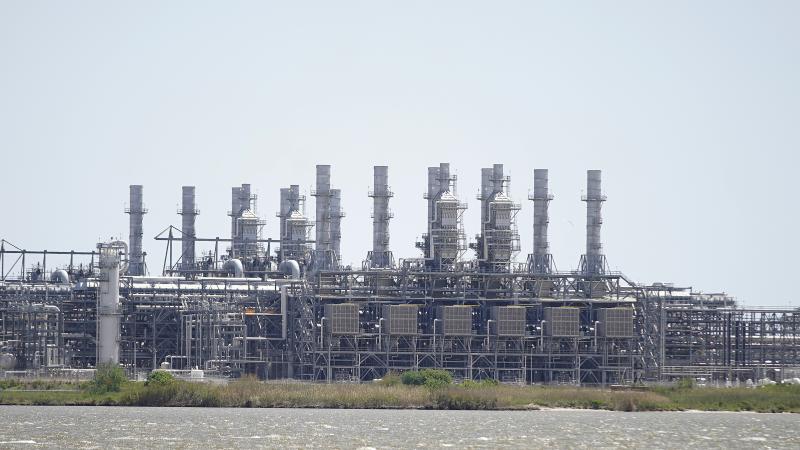Energy prices down after 100 days of Trump, as promised, but could spell trouble for companies
His detractors say Trump favors the interests of corporations over that of citizens. While oil, gas and coal companies now operate under a friendlier regulatory environment, experts warn that economic headwinds may impact the energy producers' bottom line.
Former President Joe Biden campaigned on a promise to “end fossil fuels,” and Democratic candidate Kamala Harris wasn’t planning to change the direction of U.S. energy if elected. Upon assuming office the second time, President Donald Trump signaled a shift in energy policy that would place concerns about climate change and emissions reductions in the backseat, and put energy affordability and reliability at the wheel.
The average price of gasoline in the U.S. was $3.33 per gallon in 2024, under the Biden Administration. Trump's first 100 days have seen the average price of gasoline drop to $3.15 per gallon as of April 28, 2025.
For the past 100 days, oil, gas and coal companies have operated under a friendlier regulatory environment. However, experts warn economic headwinds may place some restraint on Trump’s plan to unleash American energy. It creates a paradoxical situation in which low energy costs, which are great for consumers, aren’t necessarily good for producers.
“When Biden did something that caused oil prices to go up, it made people mad with the oil producers. If you compare how much money ExxonMobil made under Biden versus how much they made under Trump the first time around, it’s not even close,” Robert Rapier, a chemical engineer and editor-in-chief of Shale Magazine, told Just the News.
In 2023, Sen. Sheldon Whitehouse, D-R.I., responded to oil companies’ boon in 2022 by accusing them of greed-driven price gouging. He introduced legislation to stop them from being so successful.
It’s unclear how much Whitehouse truly believed that companies’ greed was deciding costs to consumers, or if he was simply pandering to an anti-corporate constituency. Now that oil companies are seeing profits falling and energy costs to consumers are down over what they were in 2022, Whitehouse and his Democratic colleagues haven’t issued any statements thanking the companies for their generosity.
Lower barriers to production
The American Energy Alliance (AEA) has been keeping a tally of actions taken by Congress and the current administration that in their view, either help or hinder energy production in the United States. In May 2022, the AEA published on their website an essay titled “100 Ways Biden and the Democrats Have Made it Harder to Produce Oil & Gas." At the time, Biden’s signature climate law, the Inflation Reduction Act, had passed the House without a single vote from Republicans, and it was making its way through the Senate.
By the time Biden left office, the list had grown to 250 actions the Biden administration and Democrats had taken that made it harder for companies to produce oil and gas, including many of the provisions of the Inflation Reduction Act that Biden signed into law in August 2022.
Last month, after a couple of months of the Trump administration, the AEA produced a list of 50 actions that the Trump administration and Congressional Republicans had taken to unleash American energy since Jan. 20. On Tuesday, the AEA updated the list, which now includes 75 items.
“In its first 100 days, the Trump administration—working with Congressional Republicans—has launched an ambitious and transformative energy agenda. Through over 75 actions, including executive orders, regulatory reforms, and legislative victories, they have dismantled barriers to energy production and strengthened the position of the United States as the global energy leader,” Tom Pyle, president of the AEA, said in a press release.
Pyle said that the Trump administration will need to sustain this momentum in the coming months if he is to continue fulfilling the promises he made to voters. “We are excited to continue monitoring this progress and commend the administration’s commitment to energy abundance,” Pyle said.
Paying less at the pump, but wider economic problems
Tim Stewart, president of the U.S. Oil and Gas Association, told Just the News that all Trump did with energy policy was return it to lawful sanity.
“We are very pleased with the actions the administration has taken in the first 100 days, but I remind people that these actions are not so much ground-breaking as simply a return to normal — a return back to the center. Having a federal leasing program is nothing new. Considering the cost of federal regulations to the taxpayer before they are enacted is how things used to be. We love these executive actions, but it also shows how far off kilter the Biden administration actually was when a return to normal appears to be something completely radical,” Stewart said.
Energy Secretary Chris Wright on Tuesday posted a list of accomplishments the Trump administration has made over the last 100 days, starting with the reversal of Biden’s pause on liquefied natural gas export permits on Jan. 21, and ending with the cancelation of $700 million of “wasteful and unnecessary” contracts on Monday.
“Today, Americans are paying less at the pump and have more choices for home appliances thanks to President Trump cutting red tape and unleashing the production of affordable, reliable, secure American energy,” Wright said in a statement.
Oil production was up for the week ending April 25, setting a new record of 13.465 million barrels of oil per day, up from 13.461 million per day this time last year. Rapier said he expects that will begin to decline.
Trump campaigned on a promise to bring down energy costs, and gas prices are down from where they were a year ago. Rapier with Shale Magazine said that low energy costs, which voters love, have impacts across the economy.
“This is not 2005 anymore. We are net exporters of oil and finished products. When oil prices go down, that hurts our trade balance. I realize that for you personally filling up your gas tank, you might say, ‘Well, that's good.’ But you have to consider why. Why are oil prices going down? What's happening?” Rapier said.
The U.S. gross domestic product shrunk in the first quarter of 2025, Rapier pointed out, and he thinks it might contract in the second quarter as well. “We’re going to be in a recession. That’s why oil prices are going down,” Rapier said.
For the past couple of years, economists have been forecasting recessions. Whether or not the contracting GDP in the first quarter signals a recession in 2025 remains to be seen, but the West Texas Intermediate price — the U.S. benchmark — was under $60 per barrel on Wednesday afternoon, according to Oilprice.com. The last time prices were this low was when the U.S. was coming out of the pandemic lockdowns in the fall of 2021.
In 100 days, Trump has made good on his promise to bring down energy costs. Over the next 100 days, the U.S. will see how lower energy costs play out in the economy and if it ultimately unleashes American energy.
The Facts Inside Our Reporter's Notebook
Links
- end fossil fuels
- change the direction of U.S. energy
- signaled a shift in energy policy
- average price
- average price of gasoline drop to $3.15 per gallon
- Shale Magazine
- stop them from being so successful
- oil companies are seeing profits falling
- American Energy Alliance
- published on their website an essay
- 250 actions
- produced a list of 50 actions
- now includes 75 items
- said in a press release
- U.S. Oil and Gas Association
- federal leasing program
- nothing new
- posted a list of accomplishments
- reversal of Bidenâs pause on liquefied natural gas export permits
- cancelation of $700 million
- setting a new record of 13.465 million barrels of oil per day
- campaigned on a promise to bring down energy costs
- gas prices are down
- shrunk in the first quarter of 2025
- economists have been forecasting recessions
- according to Oilprice.com














